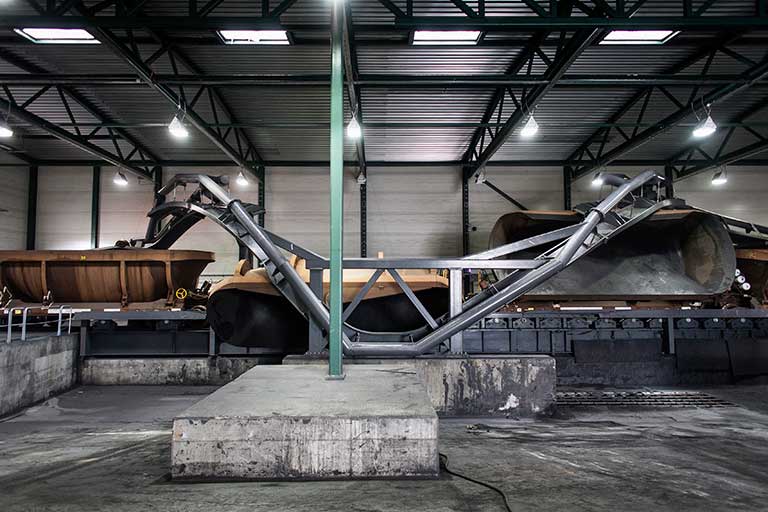One Swedish company’s innovative solution can increase the speed of mineral ore deposit mining and significantly reduce bulk transportation costs
The mineral production industries are inextricably linked with railways. Since the earliest days of mining, the problem of transporting large volumes of heavy material has seen solutions develop into the rail infrastructure we know today.
But if the basic principles of rail transportation remain unchanged since their first inception the same cannot be said for the way their bulk material cargoes are handled. Wagons with sides or bottoms that drop out to enable the freight to be dumped have been developed to speed the unloading of material, with varying degrees of success.
Now Swedish specialist bulk ore transportation system manufacturer Kiruna Wagon has developed a versatile lightweight freight wagon and unloading method that maximises payload, increases transportation efficiency, speeds unloading time and reduces delivery costs by as much as 15%.
Kiruna Wagon has used super high-strength and high wear-resistant steels from Swedish producer SSAB to develop its Helix Dumper system.
“We have been developing the system since 2010,” explains Fredrik Kangas, managing director at Kiruna Wagon. “Our client needed a system that could transport iron ore from its terminal in Sweden to Norway. We wanted to make sure that system was as efficient and cost effective as possible.”
“We could not have delivered this solution without high-strength steels”
Fredrik Kangas
Kiruna looked at and developed the concept of a rotary unloading system which steers loaded wagons along rails through a stationary structural steel corkscrew arrangement that automatically tips the hinged wagon body from its chassis, which stays on the rails.
A ‘capture wheel’ on the top of each wagon connects with the corkscrew or ‘helix’ structure and gradually tips the wagon to 148 degrees. This enables the payload to be dispensed from the curved body of the wagon as the train continues through the unloading station without losing any of its momentum.
 A side on view of Kiruna’s corkscrew unloading mechanism
A side on view of Kiruna’s corkscrew unloading mechanism
The corkscrew or helix automatically locates the empty wagon body back onto its chassis once it has discharged its load. There is no need to stop the train, dramatically increasing the unloading speed, which Kiruna Wagon claims can be as high as 25,000 tonnes per hour – double that of more conventional wagons and unloading systems.
The designers used Strenx and Hardox, advanced high strength steels developed by SSAB, to construct the system. Both steels are hardened by repeated heating and then rapid cooling in water, oil or inert gases under tight controls. They are then tempered by heating them to just below their critical temperature for a set period of time and allowing them to cool in still air. How this process is controlled determines their final hardness and ductility.
Strenx and Hardox are commonly used where thinner, stronger steels and those with high abrasion resistance are required – for example, excavator buckets, mineral rock crushers, demolition equipment, mobile cranes and road haulage wagons.
Strenx and Hardox are commonly used where thinner, stronger steels and those with high abrasion resistance are required
Strenx is an advanced high-strength structural steel and was used in both the manufacture of the helix structure and that of the wagon, where it was used in stiffeners that surround the wagon body. Hardox plate steel was used in the formation of the curved structure of the wagon itself. This provides dramatically increased wear resistance without any increase in sheet thickness, enabling the design team to provide a lightweight yet robust wagon.
“We could not have delivered this solution without high-strength steels,” says Kangas. “It just would not have been possible. There are huge dynamic and torsional loads between the wagon and the chassis as it rotates. We need the high strength for that level of load bearing and wear resistance given the abrasive nature of the cargo. There are very few stiffeners and few welds in our design.”
Since it developed the innovative Helix Dumper system, Kiruna Wagon has won the 2017 International Swedish Steel Prize, an honour that Kangas describes as “a dream”.
And this solution is not just tied to those working in the mining and minerals sector. The Helix Dumper could be just as effective in any venture where large, abrasive, loose loads are transported via the rail network.
“We have had lots of interest in the system from all over the world,” says Kangas, “there are many different applications but we anticipate more orders from the minerals and mining sectors.”
Images: Fredric Alm / Kiruna Wagon
Video: Kiruna Wagon